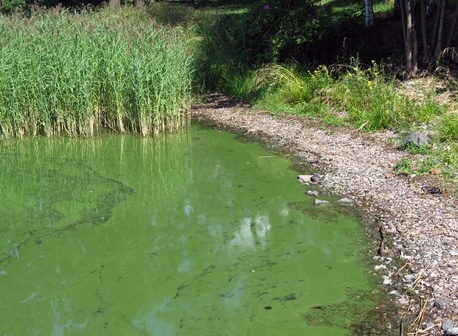Summer is a perfect time for fun outdoor play with your dog.
But too many families have lost their dogs because they didn’t know to watch for this potentially fatal hidden danger. This part 2 in my series of Keeping Your Dog Safe This Summer. If you missed part 1, How to Help Dogs with Fear of Fireworks and Thunder, click here. And part 3 is To Shave or Not to Shave? What’s Best for Your Dog?
There is the story of Annabelle. Two hours earlier, she had ridden along in a canoe drifting through Middle Foy Lake near their Montana home. As the canoe neared the shore, Annabelle leapt from the vessel, as an excited Australian Shepherd is prone to do, and swam the rest of the way to the bank. Once ashore, she licked her wet fur—a casual reflex that almost spelled her undoing.
The lake water and her coat were tainted with microcystin, a liver toxin produced by some species of blue-green algae—or cyanobacteria—thriving in the water. Quick thinking, a Google search, and an experimental therapy would ultimately save Annabelle’s life, but her story spotlights a hidden danger that abounds in freshwater bodies throughout the country. One out of three US lakes harbors hazardous levels of toxin-releasing cyanobacteria, according to the Environmental Protection Agency (EPA).
Dogs develop algae poisoning when they drink form contaminated water sources. The algae produce toxins that affect the dog’s internal organs, and depending on the concentration of algae in the dog’s stomach, the animal can die immediately or succumb later from a variety of symptoms.

Blue-green algae is prevalent in the mid-to-late summer months and is most often found in nutrient-rich water. This type of blue-green algae is different from the species that is considered a superfood, in that the superfood variety is obviously toxin free and grown in a controlled environment where it’s destined for the human food market.
Not all blue-green algae is toxic, but since there’s no way to know whether a plant is poisonous without testing, experts advise that all blooms floating on natural bodies of water should be considered potentially toxic. Even minor exposure – like a dog drinking a few mouthfuls of contaminated water – can be lethal.
Signs of Algae Poisoning
Blue-green algae is toxic not only to dogs and cats, but also to humans, horses, cows, and birds. Dogs that swim regularly in lakes and ponds are at higher risk of exposure. Hunting dogs are also at higher risk due to increased exposure outdoors.
According to Dr Karen Becker, symptoms include vomiting, diarrhea, blood in the stool or a black tarry stool, pale mucous membranes, jaundice, seizures, disorientation, coma, shock, excessive drooling or tearing, muscle tremors, muscle rigidity, bluish discoloration of skin and mucous membranes, difficulty breathing, and ultimately, death.
Symptoms depend on the toxin involved. Toxins that attack the liver cause blood work changes including elevated liver enzymes, low blood sugar, low protein, and occasionally abnormal clotting activity. These toxins can result in liver damage or failure and immediate aggressive treatment is necessary to save the animal.
If your dog shows any symptoms, it is a medical emergency! RUSH your dog to the nearest emergency clinic and tell them your dog has possibly been exposed to toxic blue green algae.
According to Christopher Gobler, a marine and atmospheric science professor at SUNY Stony Brook:
“The basic message should be, if you see a pond or lake and it has that greenish color you should keep your kids and pets away, because there is that risk.”
Here’s the link to a fact sheet from NOAA: http://www.glerl.noaa.gov/pubs/brochures/bluegreenalgae_factsheet.pdf
Do you see pea soup algae in places you play with your dog? Share how you will keep your dogs safe this summer in the comments below.
Click the Banner to Download Your Free Book and get on my VIP Subscriber list for the latest tips and insights:
 Experience Success in all you do … sports, performance and every day life.
Experience Success in all you do … sports, performance and every day life.
This FREE guide will teach you 5 Core Principles that will help you:
- Identify and Solve Your Dog Training Challenges.
- Get the Performance Results You Want.
- Be a Fun, Confident, Attentive Trainer that Your Dog Adores!







4 Responses
I first heard about this several years ago, when there was an article published either in The Whole Dog Journal or The Bark. It concerned the death of a young border collie after she had been swimming in a lake in Michigan, I believe. Very frightening! Apparently, this algae phenomena used to only occur in lakes and ponds in the western half of North America, but has spread all across the country. Here in Ohio, our largest inland lake, Grand Lake St. Mary’s, was closed to swimming and boating a couple of years ago because the toxic algae level was so high! I will not allow my dogs in any of the ponds or small lakes this time of year, only in moving water, such as creeks and rivers.
Thank you Kathy for always sharing valuable information to all dog and animal owners everywhere.
You are a blessing to us!
This article has made me wonder if the last two strays I provided a home for (Sparky, and Scruffy) were possibly sick throughout their lives because of this problem. Sparky our Lab was found dumped at a gas station wet and smelly, no one claimed him and so we kept him for 14years. Scruffy was found in a pond covered with duck weed on July 3rd over 15yrs ago and always had strange health issues and eventually developing pancreatic disease. Both dogs died at very old ages – 6 months apart, but had suffered illness of one kind or another for many years. We loved them so and miss them. Now I wonder if perhaps mild poisoning from algae had done some organ damage early in life and we and the vets just never knew to look or test for that? All in all they live long lives filled with love and giving love. In the future I will be more aware of symptoms and what to look for.
We now have a new stray from a rescue to look after us as being dog-less is not an option in our home.
Thank you for this information.
Had our sheep sheared this morning and must tell about Sky our two year old Aussie. I have not worked with her and the sheep at all but this morning the sheep got away running to pasture. Sky went after them bringing all but one of the five back to us. Niether she nor I know a thing about herding but her natural instinct bought those sheep back to the house. Don’t know how we could have gotten them back without her. When I managed to get a leash on her she walked with me taking them to a runway going to the barn. Just had to tell someone so proud of Sky